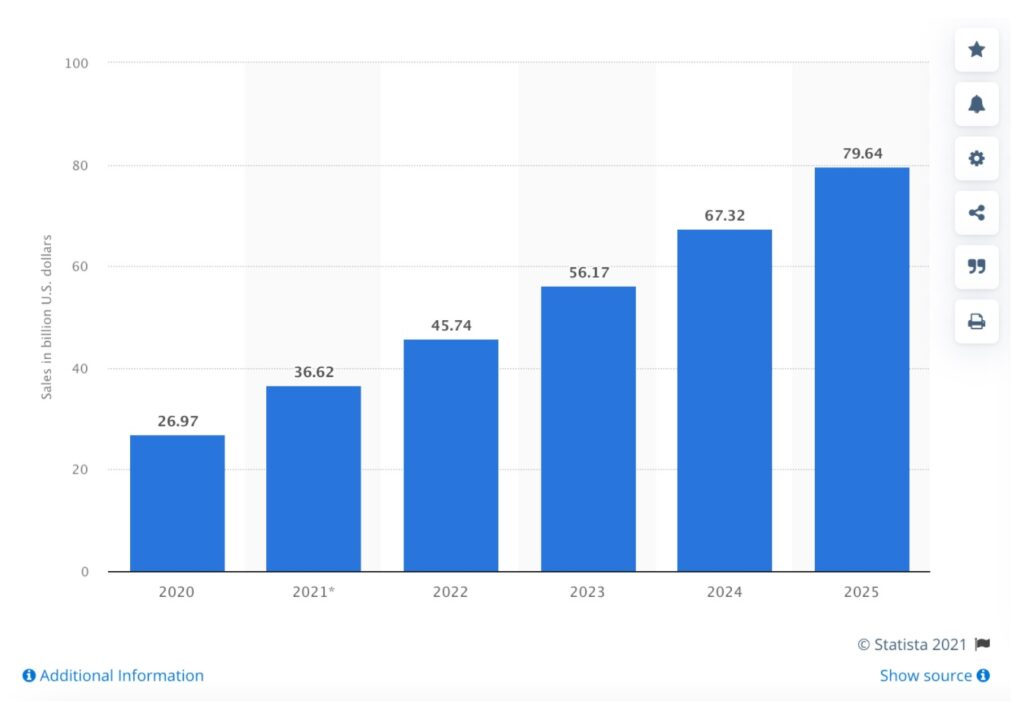According to Statista, social commerce sales in the US in 2020 were estimated at nearly 27 billion USD. As social media’s influence continues to increase, U.S. social commerce is projected to reach 79.6 billion USD in 2025 and account for 5.2% of U.S. retail e-commerce sales. Imagine in South East Asia or in other emerging markets, as more people have more access to the Internet, social commerce sales may have a similar or even bigger increase in the future.

Credit: Statista
But to embrace social commerce, we need to know what it is!
What is Social Commerce?
Social Commerce is the entire process of selling/promoting and buying a service or product through social media platforms such as Facebook, Instagram, and Twitter.
Retweets, likes, shares, or stories mentioned are the indicators to determine the success of a social commerce campaign and how the customers interact with the brand.
Social commerce also seeks to engage online shoppers by offering expert product advice and support; eventually, convert these experiences into actual actions with a “call to action”. E.g., hitting the”buy now” button after seeing a pair of Air Jordan 1 with a unique colorway for sale on a Facebook sneaker group.

Credit: Photo by Wojtek Pacześ from Pexels
Social commerce VS E-commerce: What are the differences?
You might have heard of E-commerce instead of social commerce. The main difference between these two is that social commerce is a subset of E-commerce. The former involves social media and online media platforms that support social interaction, whereas E-commerce means buying and selling goods, products, or services over the Internet.
Some experts believe that social commerce is leading the future of E-commerce. Because brands and retailers can use social media features to create engaging, shareable, and immersive advertisements that help products and services go viral in a short time. Therefore, if brands start making more use of social commerce early, they will have more advantages in taking the lead of the competition in the industry!
How can social commerce benefit your business?
“Yes, yes, I know what social commerce is now, but how can it benefit my business?” Glad you asked! Social commerce provides a more effortless journey for the customers from product discovery to purchase, and it can help the business by:
- Reaching and selling to more customers online and from ALL over the world;
- Reducing frictions in terms of communication between clients and business;
- Providing an efficient and systematic way to collect customer feedback;
- Pushing business to regularly update their social media accounts to stay in the competition which deepens trust and loyalty from the customers
What should be the right way to do social commerce?
With the more social media platforms you use, there must be more incoming messages all over the place. Of course, one should be happy with more business inquiries. However, it could become chaos if you have not established an efficient system to support all the queries without any delay. To avoid dissatisfying your potential customers, let me introduce one social commerce magic tool.
How can SleekFlow help you?
SleekFlow is an Omni-Channel Social Commerce Platform that helps you, the business owners, manage communication channels such as WhatsApp, Facebook Messenger, WeChat, Line, Instagram, Live Chat, SMS, and Email in one place. SleekFlow helps manage contacts and conversations from all these channels and makes it easier for you to respond.
Apart from centralizing channels, it leverages automation rules and targeted campaign messages to streamline sales, customer support, and marketing workflows while integrating with tools including E-commerce platforms and payment gateways to automate the customer journey with ease.
As an effective tool for social commerce, compatibility with a wide range of platforms should be vital. SleekFlow can integrate with 2500+ platforms such as online booking systems like Calendly. The definition of “one-stop” is not confined to merely the number of social media platforms but a true e-commerce ecosystem, from the customers’ side to your backend side.
For more CRM tools, you can have a quick look at our blog: CRM Systems 2021: Benefits, Comparison and Recommendations.
5 key social commerce trends in 2021
Understand the critical social commerce trends for 2021 and the future that will surely make your way to success in social commerce more minor bumping.
- Eye-catching visuals are important
According to Instagram, 70% of shopping enthusiasts turn to Instagram for product discovery. Therefore visual storefront on Instagram allows people to shop from the pictures and videos irrespective of where they are in the app. Instagram also facilitates customization with which brands can curate products into themes. - Selling through conversational chatbots
The main idea of having social media is to communicate with people. Yet, hundreds if not thousands of messages flushing into your inbox is frustrating. With the aid of chatbots, brands do not need to have a representative to answer the customers’ queries. Chatbots also can make suggestions depending upon the customers’ selections and share product visuals to boost sales with less staffing. - Collaborate with KOL/micro-influencers to increase exposure
Even if you have great products, you need more people to know about them. Inviting KOLs or micro-influencers to try on and write reviews on your products will help boost your sales by utilizing their audience base. - Live streaming
With faster networks everywhere, live streaming becomes increasingly popular. It gives the audiences a chance to know the business better through an authentic and interactive experience.
- Selling economical products
Most social media users browse the latest posts from their network to know the ongoing trends, find inspiration, or scroll and get entertained through the diverse content. Shopping is always not the primary purpose, so they tend not to buy super expensive things. So displaying “like-able” products with an acceptable price range should be prioritized.





